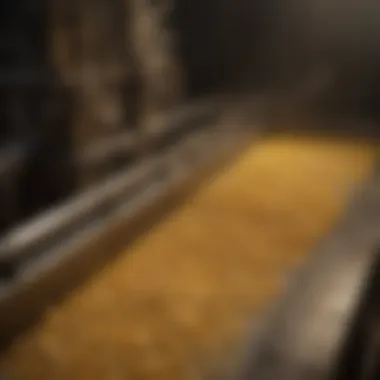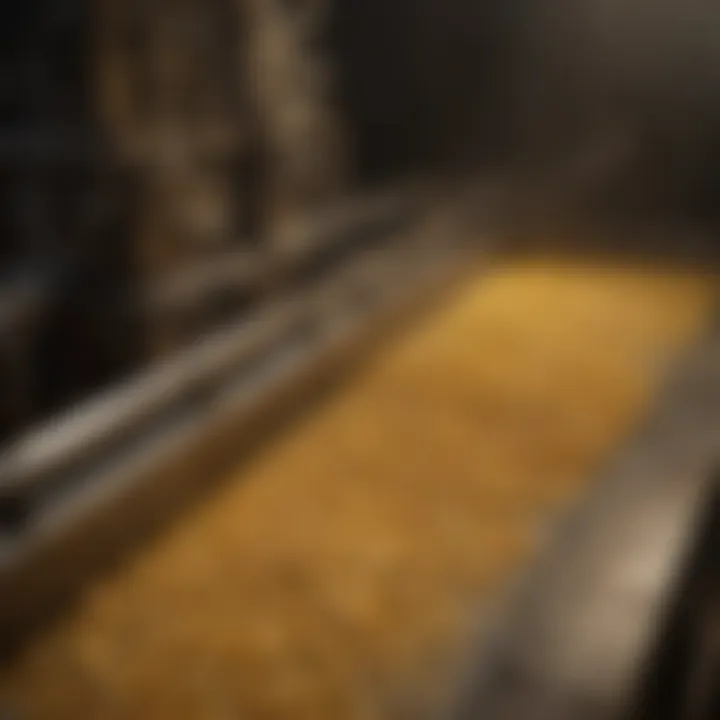In-Depth Analysis of the Corn Wet Milling Process


Intro
The corn wet milling process is a crucial industrial activity that allows the transformation of corn into various products such as starch, sweeteners, and protein. Understanding this process is essential, as it plays a significant role in various sectors, including food production, biofuels, and material science. In this article, we will explore the key components that define the corn wet milling process and its implications for the economy and environment.
By examining the stages involved, we find that each phase is interconnected. From steeping the corn kernels to extracting and purifying desired components, the process holds complexity and practical application. Furthermore, the technical aspects reveal insights about biochemical mechanisms at play and how these influence the operational efficiency of the industry. This exploration not only aims to enhance understanding but also highlights the importance of sustainable practices in corn utilization.
In this detailed analysis, we will discuss the economic significance of wet milling, the various products derived from the process, and the current trends influencing the industry. Additionally, environmental issues will be addressed, providing readers with a comprehensive overview of sustainable developments in corn wet milling.
Preface to Corn Wet Milling
The corn wet milling process represents a cornerstone of food and industrial production. Through this complex method, corn is transformed into a wide array of valuable products such as starch, sweeteners, and proteins. Understanding this process is crucial for various stakeholders, including students, researchers, and industry professionals, as it encapsulates not just the techniques involved but also the broader economic and environmental implications.
In this section, we delve into the definition and importance of corn wet milling and examine its historical context. Insight into these aspects establishes a foundation for appreciating the intricacies of each phase involved in corn wet milling.
Definition and Importance
Corn wet milling is a separation process where water is used to disintegrate the corn kernel, allowing for the extraction of its components. This method is predominantly employed in the production of food products, industrial starches, and bioproducts. The process utilizes the inherent physical and chemical properties of corn, enabling the isolation of starch, gluten, and oil among other byproducts.
The significance of this process is underscored by its adaptability and yield. For instance, wet milling allows for a recovery rate of up to 90% of the corn kernel components. This efficiency highlights its crucial role in maximizing resource utilization, especially in an era where sustainable practices are gaining momentum. Moreover, the economic implications are profound, as wet milling is a multibillion-dollar industry that serves diverse markets, spanning food, beverage, and even biofuel sectors.
Historical Context
The roots of corn wet milling extend back to early civilizations that recognized the value of corn as a staple crop. Historic records suggest that indigenous peoples in the Americas were utilizing basic milling techniques long before industrial advancements. However, the modern corn wet milling process began to take shape in the late 19th century when innovations in milling equipment and chemistry paved the way for more efficient extraction methods.
By the 1930s, the industry saw a notable transformation with the introduction of more sophisticated machinery and better processing techniques. Major corporations emerged, driving the need for continuous improvement and re-engineering of the production processes. As a result, various products derived from corn began to escalate in availability and significance in global markets.
The evolution of technology and production methods in this sector reflects broader trends in agricultural practices and industrial development. Today, corn wet milling not only supports local economies but also plays a pivotal role in global food supply chains and industrial advancements. Each of these historical milestones contributes to a greater understanding of the present state of corn wet milling and its future directions.
Key Components of Corn
The study of the key components of corn holds immense relevance in the context of the corn wet milling process. Understanding the complex structure and properties of corn is pivotal in maximizing its utility for industrial applications. The corn kernel is composed largely of starch, though it also contains protein, fiber, and small quantities of fats and minerals. Each of these components plays a significant role in various wet milling outputs. Moreover, knowledge of corn composition aids in selecting the appropriate corn varieties to meet specific production goals and enhance product quality. The ultimate objective is to achieve a high yield of desired products while minimizing waste and improving efficiency in the milling operation.
Corn Composition
Corn is primarily made up of three components: the endosperm, germ, and pericarp. The endosperm, which constitutes about 80% of the corn kernel, is the main source of starch and is crucial for wet milling. The starch can be further processed into various products like corn syrup and sweeteners.
The germ is a smaller part and is rich in oil and protein. This component is vital for producing protein products such as corn gluten meal and oil, which are also important in the food industry. The pericarp, or the outer hull of the kernel, contributes fiber and is often removed during milling but can be utilized for other applications, such as animal feed. Understanding the specific composition enables manufacturers to select optimal milling conditions tailored to their product requirements.
Nutritional Aspects
Nutritionally, corn offers significant benefits. It is a rich source of carbohydrates, primarily in the form of starch. The presence of protein accounts for about 8-10% of the kernel, with the amino acid profile complemented by additional protein sources in formulations. While corn is relatively low in essential nutrients compared to other grains, it contains valuable vitamins such as vitamin B and important minerals like magnesium and potassium.
Additionally, corn's fiber content contributes to digestive health. In wet milling, separating these components not only maximizes yield but also addresses consumer demands for healthier food products.
"Understanding the nutritional profile of corn can lead to innovative applications in food technology, enhancing product appeal and consumer satisfaction."
Pre-Milling Preparation
Pre-milling preparation serves as a fundamental step in the corn wet milling process. It sets the stage for the subsequent steps by ensuring that the corn is suitably conditioned and ready for efficient milling. Without thorough preparation, inefficiencies can arise, leading to lower product yield and reduced quality.
Selection of Corn Varieties
The selection of corn varieties is critical in the wet milling operation. Different varieties possess distinct physical and biochemical properties that influence their suitability for milling. Factors such as kernel hardness, moisture content, and starch composition play crucial roles.
Some varieties, including dent corn, are preferred because of their high starch content. This specific corn type facilitates the extraction of starch and protein, optimizing yield. Farmers and processors must collaborate closely to identify the best varieties for their specific needs.
Moreover, genetic traits in these corn varieties can enhance various aspects of the milling process. For example, advancements in breeding may produce strains that are more resistant to pests and environmental stressors. This factor not only maximizes yield but also significantly reduces reliance on chemical treatments, thus promoting a sustainable approach to agriculture.
Cleaning and Conditioning


Cleaning and conditioning are essential steps following the selection of the appropriate corn variety. This phase addresses the removal of impurities and ensures the corn is in the best condition for milling. In this context, impurities may include foreign materials like dirt, stones, and other grains that can affect the final product quality.
The cleaning process typically employs a variety of equipment such as screens, magnets, and air classifiers. These tools effectively filter out contaminants, resulting in a cleaner product. Following cleaning, conditioning is carried out to maintain optimal moisture levels in the corn. The moisture content is usually adjusted to around 20% to facilitate easier milling and starch extraction. Proper conditioning softens the corn and improves the efficiency of the grinding process.
Inadequate cleaning or improper conditioning can lead to significant challenges during milling, affecting both yield and quality. For instance, poorly cleaned corn can introduce unwanted flavors or residues into the final products. Thus, diligence in this preparatory phase is critical, laying the groundwork for a successful wet milling operation.
The Wet Milling Process Explained
The corn wet milling process is a vital industrial operation that is the backbone of numerous products and applications in various sectors. This section explores the multi-faceted aspects of this process and its significance.
Understanding the wet milling process is crucial for professionals, researchers, and academics alike. It not only sheds light on how raw corn is converted into valuable by-products but also enhances knowledge of the biochemical aspects and economic implications tied to this operation. The process involves several intricate steps, each contributing to the overall efficiency and effectiveness of corn conversion.
Furthermore, the wet milling process addresses various considerations such as product quality, yield optimization, and waste management. These elements are essential in creating sustainable practices within the industry. As consumer demands evolve, knowledge of this process becomes increasingly relevant.
Soaking Step
The soaking step is the initial phase of the corn wet milling process. This part involves immersing the corn kernels in water. The primary goal is to soften the kernels, which makes it easier for subsequent milling operations.
During soaking, the corn absorbs water at a controlled temperature. This hydration is crucial because it swells the kernels and initiates the enzymatic breakdown of starches. Enzymes play a significant role in enhancing the overall efficiency of starch separation later in the process.
Moreover, the soaking step typically lasts for 24 to 48 hours, depending on the specific conditions and desired outcomes. Proper soaking is essential, as insufficient hydration may lead to lower yields of starch and other products.
Milling Operations
The milling operation follows the soaking step and is a central aspect of the corn wet milling process. Here, the softened kernels undergo mechanical processing. The main objective is to separate the corn into its constituent parts such as starch, gluten, and fiber. This separation is conducted through a series of mechanical and hydraulic actions.
Different types of mills, including impact and roller mills, can be utilized. The choice largely depends on the desired product characteristics. During this phase, extraction efficiency is key. Operating conditions, such as pressure and temperature, must be carefully monitored to optimize yield.
Properly executed milling operations lead to a higher purity of starch, which is essential for various applications in food, paper, and textile industries. Effective milling can also enhance the recovery of valuable protein products.
Separation Techniques
After milling, separating the different components of the corn is essential. Several techniques can be employed during this stage, each serving specific purposes. The most common methods include centrifugation, screening, and sedimentation.
Centrifugation uses centrifugal force to separate components based on density. This technique is particularly efficient in isolating starch from proteins and other solids. Screening utilizes a series of filters to separate materials of different sizes, while sedimentation allows heavier particles to settle out naturally.
The choice of separation technique impacts the quality and yield of the final products. For instance, optimal starch recovery often requires fine-tuning process parameters to ensure maximum efficiency. As sustainability plays an ever-increasing role in industrial processes, advancements in separation techniques aim to minimize waste and improve the overall efficacy of the wet milling process.
"The corn wet milling process is not only crucial for product generation but also for enhancing sustainability within the industry."
Through these sequential steps, the wet milling process transforms corn into numerous valuable products, making it an essential operation in industrial agriculture. Understanding each component of this complex process is vital for those involved in academia, research, or industry.
Key Products from Wet Milling
The corn wet milling process leads to the production of several key products that are essential to various industries. These products have significant applications in food production, pharmaceuticals, and even biodegradable materials. Understanding these products helps unpack the economic benefits and industry relevance of wet milling. Each product derived from this process is unique, serving different consumer needs and contributing to a sustainable economy. The primary products include corn starch, protein products, and sweeteners. These components are not just byproducts; they represent valuable resources that drive consumer markets.
Corn Starch
Corn starch is one of the most prominent products obtained from the wet milling process. It is a white powder derived from the endosperm of corn kernels. The importance of corn starch cannot be overstated. It acts as a thickener, stabilizer, and texturizer in various food products including sauces, soups, and desserts. Additionally, corn starch is used in the manufacturing of paper and textiles, illustrating its versatility beyond the food industry.
The production of corn starch involves several steps, including steeping, milling, and separating the starch from other components. The final product is often modified to enhance its properties for specific applications. For instance:
- Food Industry: Used in gravies and pudding for thickening.
- Industrial Use: Involved in the production of biodegradable plastics.
The economic significance of corn starch production is evidenced by its high demand. It is a staple in many households and industries, demonstrating the integral role of wet milling.
Protein Products
Protein products derived from wet milling, especially corn gluten feed and corn gluten meal, hold significant value in the market. These products are primarily used as animal feed, providing essential nutrients that support livestock health and productivity. Corn gluten meal is a high-protein feed ingredient that is particularly popular in the poultry and aquaculture sectors.
Moreover, these protein products are considered to be a sustainable source of nutrition. They utilize parts of the corn that might otherwise go to waste. Highlights of corn protein products include:


- High Nutritional Value: Rich in amino acids, supporting animal growth.
- Sustainable Practices: Contributes to reduced environmental impact by maximizing corn utilization.
The relevance extends into research for human nutrition. Studies explore how corn protein could serve in the development of plant-based diets, appealing to health-conscious consumers.
Sweeteners
Sweeteners derived from corn, particularly high-fructose corn syrup and corn syrup, have transformed the food and beverage industry. High-fructose corn syrup is widely used as a sweetener in soft drinks, sauces, and packaged foods. These sweeteners are favored not only for their sweetness but also for their cost-effectiveness compared to traditional sugar sources.
Key aspects regarding corn sweeteners are:
- Availability: Easy to produce and scale, making them a staple in processed foods.
- Health Considerations: Their use is sometimes criticized due to potential health impacts, prompting research and discussions around balance and alternatives.
Sweeteners provide significant insights into consumer behavior and trends. As people become more conscious of dietary choices, the industry continues to innovate, seeking alternatives and more natural sweetening options.
Technological Innovations
Technological innovations play a pivotal role in enhancing the corn wet milling process. It involves the integration of state-of-the-art machinery and processes that increase efficiency, reduce waste, and improve product quality. The following segments detail the advancements in milling equipment and bioprocessing techniques, both vital for optimizing production and addressing modern industry challenges.
Advancements in Milling Equipment
The milling equipment used in corn wet milling has undergone significant advancements in recent years. Modern mills are designed to maximize throughput while minimizing energy consumption.
- High-Efficiency Separators: New separators ensure that the extraction of starch, gluten, and other components is more precise. This not only leads to higher yields but also enhances the purity of each product.
- Automated Systems: Automation reduces human error and increases consistency in the milling process. Automated systems allow for continuous monitoring of parameters such as moisture content, temperature, and pressure.
- Enhanced Wear Resistance: Equipment made with advanced materials extends the lifespan of milling machines. This leads to lower maintenance costs and less downtime, further contributing to the overall efficiency of operations.
These advances contribute significantly to the reduction of operational costs and improve the sustainability of the corn wet milling process.
Bioprocessing Techniques
Bioprocessing techniques have emerged as crucial methods in the corn wet milling industry. These methods involve biological systems to produce valuable products efficiently with minimal environmental impact.
- Enzymatic Processes: Utilizing enzymes enhances the breakdown of starches into simpler sugars. This leads to higher yields of glucose and other sweeteners that are in demand in various industries.
- Fermentation Technologies: Fermentation processes convert starch into ethanol or other biochemicals. This aligns with the growing interest in biofuels and alternative energy sources.
- Biorefinery Approaches: The concept of biorefineries integrates multiple products from the corn wet milling process. It allows for the simultaneous production of food ingredients and biofuels, maximizing resource utilization.
These bioprocessing techniques present new opportunities for product development and a pathway to a more sustainable and efficient industry.
"Innovation in corn wet milling is not just about improving equipment; it is about creating a holistic approach that encompasses both technological enhancements and sustainable practices."
Overall, the integration of these technological innovations has led to improved efficiency, better product yields, and an environmentally-friendly approach to corn wet milling, thus shaping the future of the industry.
Economic Impact of Corn Wet Milling
The economic impact of corn wet milling is far-reaching and multifaceted. This process not only contributes significantly to food industries but also affects global markets in many ways. Corn wet milling transforms corn into various products such as starch, sweeteners, and proteins, which are essential to multiple sectors including food, pharmaceuticals, and bioplastics. Understanding this impact aids in grasping the process's relevance in today's economy.
Market Dynamics
In the realm of market dynamics, corn wet milling plays a crucial role. The industry is driven by the demand for corn-derived products. The increasing need for high-fructose corn syrup, modified starches, and other derivatives has made wet milling an essential operation. As consumer preferences shift towards healthier options, there is a growing demand for natural sweeteners and food additives sourced from corn.
Several factors influence market dynamics:
- Supply Chain Factors: The stability of corn supply affects milling operations. Weather conditions, agricultural practices, and economic policies are vital considerations.
- Pricing Trends: The price of corn impacts product costs. Fluctuations can arise from global trade conditions, tariffs, and local agricultural outputs.
- Technological Advancements: Improvements in milling technology enhance efficiency and reduce production costs, making corn products more competitive in the marketplace.
These elements create a dynamic market landscape for corn wet milling, influencing everything from production volume to pricing strategies.
Global Trade Implications
Global trade implications are significant due to the nature of corn production and processing. The corn wet milling sector is a key player in international markets, with many countries engaged in the trade of corn fractions and products. Countries such as the United States, Brazil, and Argentina are the primary producers, heavily influencing global prices.
Impacts include:
- Export Opportunities: Corn products are exported widely, creating economic benefits for producing countries. The USA, for example, exports corn sweeteners and starches to various nations, thereby contributing to its GDP.
- Trade Agreements: Trade policies and agreements can open new markets or restrict access, directly impacting how corn wet milling companies operate. For example, changes in NAFTA have affected trade flows in North America.
- Competition: Global players drive competition, pushing companies to innovate. This, in turn, enhances the availability and quality of corn products around the world.


"The global nature of corn wet milling not only shapes local economies but also dictates market trends worldwide."
Environmental Considerations
The environmental impact of corn wet milling is a multifaceted topic that merits careful examination. As industries evolve, the focus on sustainable practices and responsible resource management has grown. In the context of corn wet milling, understanding environmental considerations is crucial for several reasons. First, the production processes in this industry can result in significant waste generation and emissions. Therefore, addressing these concerns leads to more efficient operations that align with contemporary ecological expectations.
Another aspect is the potential for water usage and contamination. The soaking and processing of corn require substantial amounts of water. It is vital for mills to adopt practices that minimize water consumption and prevent pollution in surrounding ecosystems. Implementing effective waste treatment solutions is paramount in reducing the environmental burden.
"The corn wet milling process must integrate sustainability into its core operations for long-term viability."
Waste Treatment Solutions
Waste management in corn wet milling involves the treatment and disposal of by-products that result from milling activities. These by-products can include organic waste, starch sludge, and wastewater, which pose both disposal and environmental challenges. Modern mills are increasingly adopting innovative treatment solutions designed to minimize waste and optimize resource recovery.
Several common strategies include:
- Anaerobic Digestion: This process uses microorganisms to break down organic waste in the absence of oxygen, resulting in biogas production. This biogas can be repurposed to generate energy, reducing reliance on fossil fuels.
- Water Recycling: Systems that enable the recycling of water used in processing help reduce overall consumption and lessen the ecological footprint of the milling operations.
- Bioprocessing of By-products: Corn gluten feed, a by-product of the wet milling process, can be repurposed as animal feed, thus reducing overall waste generated and enhancing economic value.
Implementing these waste treatment solutions not only safeguards the environment but also presents financial incentives that strengthen the industry’s sustainable framework.
Sustainability Practices
Sustainability in corn wet milling emphasizes the efficient use of resources and the minimization of environmental impact. Mills are increasingly required to adopt practices that reflect this commitment. A few prevalent sustainability practices include:
- Energy Efficiency: Reducing energy consumption through advanced equipment and processes leads to lower carbon emissions. The shift towards renewable energy sources in powering milling operations also plays a significant role.
- Sustainable Sourcing: Ensuring that corn is sourced from farms practicing sustainable agriculture fosters an ecosystem that prioritizes soil health, biodiversity, and the reduction of chemical inputs.
- Waste Minimization: A focused approach to reducing waste at every stage of the milling process can substantially lessen the environmental impact. This involves not only improving operational efficiencies but also engaging in a circular economy framework where by-products are turned into new resources.
Engaging in these sustainable practices not only benefits the environment but enhances the reputation of the corn wet milling industry. As market demands shift toward eco-friendly and socially responsible businesses, integrating these elements becomes central to long-term competitiveness and success.
Future Trends in Corn Wet Milling
The corn wet milling industry is undergoing significant transformation driven by various future trends. As this sector evolves, these trends not only shape production methods but also influence market dynamics and consumer expectations. Understanding these factors can provide invaluable insights for stakeholders at all levels, from industry professionals to researchers. The importance of this topic stems from the pressing need to adapt to technological advancements, sustainability initiatives, and shifting consumer preferences.
Emerging Technologies
Emerging technologies play a pivotal role in refining the corn wet milling process. Modern milling equipment is evolving to improve efficiency and reduce waste. For example, innovations in enzyme applications are enhancing starch conversion rates. This leads to higher yield and better quality products. Sophisticated separation techniques, such as membrane filtration, are being adopted to streamline the separation of components. Enhanced automation and real-time data monitoring are also setting new standards. These technologies reduce human error and increase operational precision. The integration of artificial intelligence is poised to transform process control further, anticipating issues before they occur.
Key benefits of emerging technologies include:
- Improved Operational Efficiency
- Enhanced Product Quality
- Reduced Production Costs
- Lower Environmental Impact
Shifts in Consumer Demand
Shifts in consumer demand are reshaping the corn wet milling landscape. Today’s consumers are increasingly aware of the nutritional properties and environmental impact of food products. These changing preferences drive the corn wet milling industry toward greater transparency and sustainability. Significant interest is growing in products derived from whole grains and less processed options. As consumers shift towards healthier choices, corn wet milling operations must adapt by producing products that meet these evolving demands. This includes gluten-free options and non-GMO products. The rise of plant-based diets and sustainable sourcing further influences producer decisions.
The emphasis on ethical production is also becoming more pronounced. Consumers are encouraging companies to adopt practices that support the environment and local communities. Hence, businesses engaged in corn wet milling must navigate these demands or risk losing relevance.
"Future trends indicate that staying attuned to consumer preferences will be essential for success in the corn wet milling sector."
Culmination and Insights
The section on conclusion and insights synthesizes the key findings of the article on the corn wet milling process. It helps to encapsulate the various aspects discussed throughout the piece while providing a reflective analysis. Highlighting practical implications for industry stakeholders and the importance of sustainable practices is crucial. Understanding these points can lead to improved operational efficiencies and better alignment with consumer demands.
The significance of the corn wet milling process cannot be overstated. It plays a pivotal role in food production, and its implications stretch far into the industrial landscape. Different products derived from corn, such as starches and sweeteners, contribute to numerous sectors including food and beverage, pharmaceuticals, and even biofuels. Thus, a clear comprehension of this process facilitates greater economic awareness and potential innovation.
"The corn wet milling process is essential for creating high-value by-products that serve diverse markets."
Key Takeaways
- Operational Knowledge: Familiarity with each stage of the corn wet milling process enhances professional competency in relevant industries.
- Market Trends: Awareness of evolving market dynamics aids companies in adjusting their strategies toward new consumer preferences.
- Technological Advancements: Innovations in milling technology promise increased efficiency and cost reductions, necessitating continuous education in industry practices.
- Environmental Responsibility: Recognizing the significance of sustainable practices is crucial. Engaging with waste treatment solutions and environmental impacts is vital for industry credibility.
Recommendations for Further Research
Research boundaries can be expansively broadened in the field of corn wet milling. Future studies can focus on:
- Developing more efficient milling processes that minimize waste.
- Investigating alternative uses of corn derivatives that may align with emerging market needs.
- Exploring how advancements in biotechnology and genetic modifications of corn can impact its suitability for wet milling.
- Analyzing global trade patterns to better assess how fluctuations in corn prices affect milling operations worldwide.
Such inquiries can assist in pushing the boundaries of existing knowledge while fostering innovation within this crucial sector.







